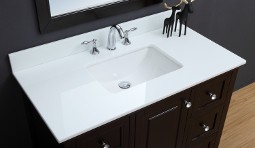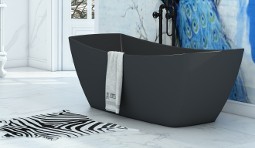
Choose the right materials, style and size for a vanity that fits your bathroom and works for your needs
It's not always the most glamorous part of a bathroom remodel, but choosing the right vanity can make or break your bathroom's design. If it's placed awkwardly in a traffic route, uses poor or mismatched materials, or doesn't have enough storage, the rest of your bathroom will suffer.
1. Placement
Access. Choose a spot for your vanity that won't mess with your bathroom's traffic flow or block the bathroom door or shower door swing. Beth Fillerup of Native Trails advises homeowners to think about cleaning and about the vanity door swing space, too. Good questions to ask, she says, include: "Are the surrounding areas accessible for cleaning? If the vanity has doors, is the space around the vanity adequate for foot traffic when they are open?"
Designer Robert Berkovich of European Cabinets & Design Studio suggests that homeowners take other architectural features into account when deciding on a spot, too. Make sure that any windows nearby will allow for a mirror and wall cabinets above the vanity. "Remember, the vanity plays an integral role in the function of the bathroom and requires the space around it to function properly," says designer Steve O'Neill of Van-i-tY.
Plumbing. If you need to change your bathroom's plumbing to install your new vanity, it's going to account for a chunk of your budget. Even switching from a traditional floor-mounted vanity to a wall-mounted version will mean rerouting pipes and drains. "Locating the vanity far from other bath fixtures requires a higher cost for rough plumbing," says contractor David Lawson of Ironwood Builders.
2. Materials
"Vanities are placed in environments that are humid, wet and busy," says O'Neill. "The materials that make up your vanity of choice should be able to stand up to such an environment." Wood veneers, laminates and thermofoil tend to work well in bathrooms. "We do caution our clients that clear finishes are generally lacquer and that water will affect the finish if it is left standing on it," he says. Designer Gina Adamson of Cab-I-Net recommends avoiding pressed MDF too, since it's susceptible to water damage.
Look for a durable vanity top as well, and try to avoid anything with hard-to-clean grout. If you're redoing other bathroom finishes, consider choosing your vanity top first. "It's so much easier to find a tile and cabinet to match a unique countertop than trying to find a top to match a unique tile," says designer Lori Hethmon. "When you choose a dynamic tile first, you may be limiting yourself to more mundane countertop choices that won't compete with your particular tile."
3. Storage
Taking account of what you truly use will help you decide how much storage you'll need in your new vanity. Take inventory of what you store in your current vanity. Organize everything by what you'll need to have in reach and what you'll just need to have nearby. "This will put into perspective what you need to store and where it needs to be placed," says O'Neill. Lawson recommends adding about 20 percent more space than you think you'll need, just to be safe.
Hanging vanities with drawers can provide a good amount of storage, since they take advantage of the often-unused space around plumbing. Berkovich suggests avoiding bulky medicine cabinets but often uses wall cabinetry (at least 10 inches deep) to add storage.
4. Size
Scale. Your vanity size should always make sense for your bathroom's size. Cramming a huge vanity into a tiny bathroom doesn't make sense, no matter what your storage needs are. "The amount of storage required by the client impacts the size of the vanity," says Lawson. "But more important is the size of the room it sits in. Working within the architecture is part of the equation."
"By evaluating lifestyle, whether a powder room or master bath, and the demands that will be placed on the vanity, the size will become evident quickly," says O'Neill. For regularly used bathrooms, Adamson recommends starting with a vanity that's a minimum of 21 inches deep and 24 inches wide.
Height. “Consider who is using the vanity to decide on the proper height,” says Adamson. “Too tall or too short can be equally frustrating.” Traditionally, 32 inches is the go-to height measurement for bathroom vanities. But some designers disagree with that measurement due to modern sink styles. Berkovich suggests aiming for 34 to 35 inches.
Source: https://www.houzz.com/ideabooks/7688299/list/bathroom-design-how-to-pick-out-a-vanity

































